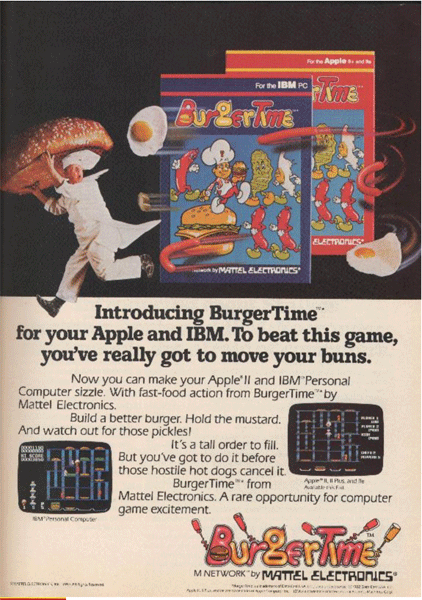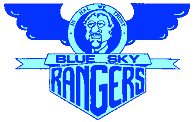Mattel Games for Personal Computers



With M Network Atari 2600 games, Mattel Electronics had expanded beyond programming just for Intellivision. The next logical step was to produce games for personal computers. The first machines targeted: the Apple II and the IBM PC.
The Apple II, introduced in 1977, had sold around 2 million units by 1982, making it the dominant machine in the personal computer market. And the new, heavily promoted IBM PC was looking like a serious challenger.
What was particularly attractive to Mattel was that no company dominated the game market for the Apple II. And game titles for the IBM PC were almost nonexistent. Unlike the video game market where Mattel was playing catch-up with Atari, Mattel could get in on the ground floor.
Both the Apple II and the IBM PC could support color graphics, which was essential. While all-text or monochrome games were still the standard on the Apple, Marketing insisted that Mattel's releases be Intellivision-style colorful arcade games.
The initial development of the M Network computer titles began in California under the direction of Manager Bill Fisher (Space Hawk). Experienced Intellivision programmers Ji Wen Tsao (Shark! Shark!) and Gene Smith (Bomb Squad) started learning the IBM PC.
The powers that be decided that the Apple II programming would be done overseas. Mattel Electronics Ltd., Taiwan (MELT), a partnership between Mattel and China Gulf Plastics (later China General Plastics), the company that molded heads for Barbie dolls, was set up to do the work.
Bill spent two months in Taiwan working with MELT Manager Swan Chen to staff and train the office there. Work began on the Apple II games, mostly conversions of existing Intellivision titles.
At the January 1983 Consumer Electronics Show in Las Vegas, Mattel Electronics announced that three titles – BurgerTime, Lock 'N' Chase and Night Stalker – would be released that year for the Apple II and IBM PC.
While Ji Wen and Gene worked on the IBM PC versions of these games in California, the Apple II versions plus other games were being programmed in Taiwan.
This created an unexpected problem: when Bill left Taiwan, their customs service determined that any computer disks with programming on them would be subject to a hefty export duty. Furthermore, any disks mailed from Taiwan to Mattel in California would be subject to inspection and export tax. Bill saw that regularly reviewing software updates by mail would seriously slow development if every disk was going to be delayed in customs.
On his return, Bill came up with what was, for early 1983, a novel solution: the games in development could be sent from Taiwan over phone lines using modems. Calling from home late at night because of the time difference, Bill would dial - actually dial; he didn't have a Touch Tone phone - about 30 digits (Mattel calling card plus the overseas number) and ask Swan Chen to enable the Taiwan BBS. Bill would then place his receiver into an acoustic coupler so that his modem could talk to the one in Taiwan. Sometimes, the connection protocol wouldn't grab, so Bill would actually pick up the receiver and hum the proper frequency until the modems connected, then he'd replace the receiver. Once the modems connected, data would start to flow across the Pacific at a blazing 300 baud. Usually, Bill would just go to bed and check on the transfer in the morning.
While that problem was relatively easy to solve, what gave Mattel heartburn was the idea of how easy it was to copy computer software. Mattel first approached an outside firm that boasted the best copy-protection scheme on the market. They wanted one dollar a disk for the license. But given one of the company's protected sample disks, Gene Smith was able to crack it - successfully making a working copy - by the end of the day.
Instead, Gene developed his own anti-piracy scheme for the IBM PC while Bill developed one for the Apple II. While both schemes were extremely intricate (Gene's a bit too intricate: the discs wouldn't run on subsequent generations of PCs), bootleg copies were spotted before the games were even on the shelves. (Bill - who personally kept all copies locked up at Mattel - suspects a leak at the disc duplication house.)
But while Mattel worried a lot about pirated copies getting out, they seemed less concerned about the distribution of legitimate copies. In those days before computer superstores, software was mostly sold in local independent shops and small software chains. The M Network Apple and IBM PC games were only available at Toys R Us and the ComputerLand chain.
Looking into the problem, Bill found that Mattel was not using SoftSel, the largest US software distributor. Instead, Mattel was relying on its own sales network. Unfortunately, while Mattel's sales people were experienced with toy stores, they were beginners in the computer market.
Bill fired off an angry memo: "The whole personal computer area has been treated like a backwater in this company. Our products are treated like they are insignificant. [W]hy can't we at least TRY to sell some Apple games? We're losing money like crazy..." He pointed out that Atari had just begun an aggressive campaign to market their games on Apple, IBM PC, Commodore 64, VIC 20 and TI 99/4. But it was too late for the Christmas 1983 season. Few Mattel computer games got into the hands of consumers. (Today, while Mattel's Intellivision and Atari 2600 games are fondly remembered, even many hard-core collectors are surprised to learn that Mattel Electronics was a pioneer in PC games.)
In August 1983, major layoffs at Mattel effectively eliminated the Design & Development department. A few experienced Apple II programmers were transferred from D&D into Bill's group, where they worked on converting lower-priority Intellivision titles to Apple. None of these made it onto the official release schedule. At about the same time, the Taiwan office expanded into IBM PC programming. Work started there on IBM PC versions of high-priority titles such as Masters of the Universe and Treasure of Tarmin. But Marketing was pinning their hopes for 1984 on the forthcoming IBM PC Jr. Where the PC was seen primarily as a business machine, the PC Jr. would be targeted at the home market. And the software would be on cartridges, making games harder to bootleg. Marketing committed to a full slate of PC Jr. games, with the titles to be done in California and in the Mattel Electronics office in France. Late in 1983, Bill and his California team started looking into developing for the unreleased system, nicknamed "Peanut," but Mattel Electronics closed before serious work was done. (As a postscript, when the PC Jr. was released, it flopped. It is barely remembered today.)
Late in 1983, Marketing also made a commitment to release games for the Commodore 64 computer. These games would be developed in the Mattel Electronics office in France. The only problem: the French office didn't have any Commodore 64s. In a December 20, 1983 internal status report, the schedule for those games is listed as "dependent on equipment availability," possibly delaying their release until "the first half of 1985." One month to the day after that status report, Mattel Electronics was shut down.
Due to the partnership status with China Gulf Plastics, the Taiwan office didn't close with the rest of Mattel Electronics. Work continued with new titles such as Rat 'N' Cat and Warship in the hopes of interesting another publisher. None was found, however, and the office eventually shut down.
Here is a list of the unfinished and unscheduled games:
